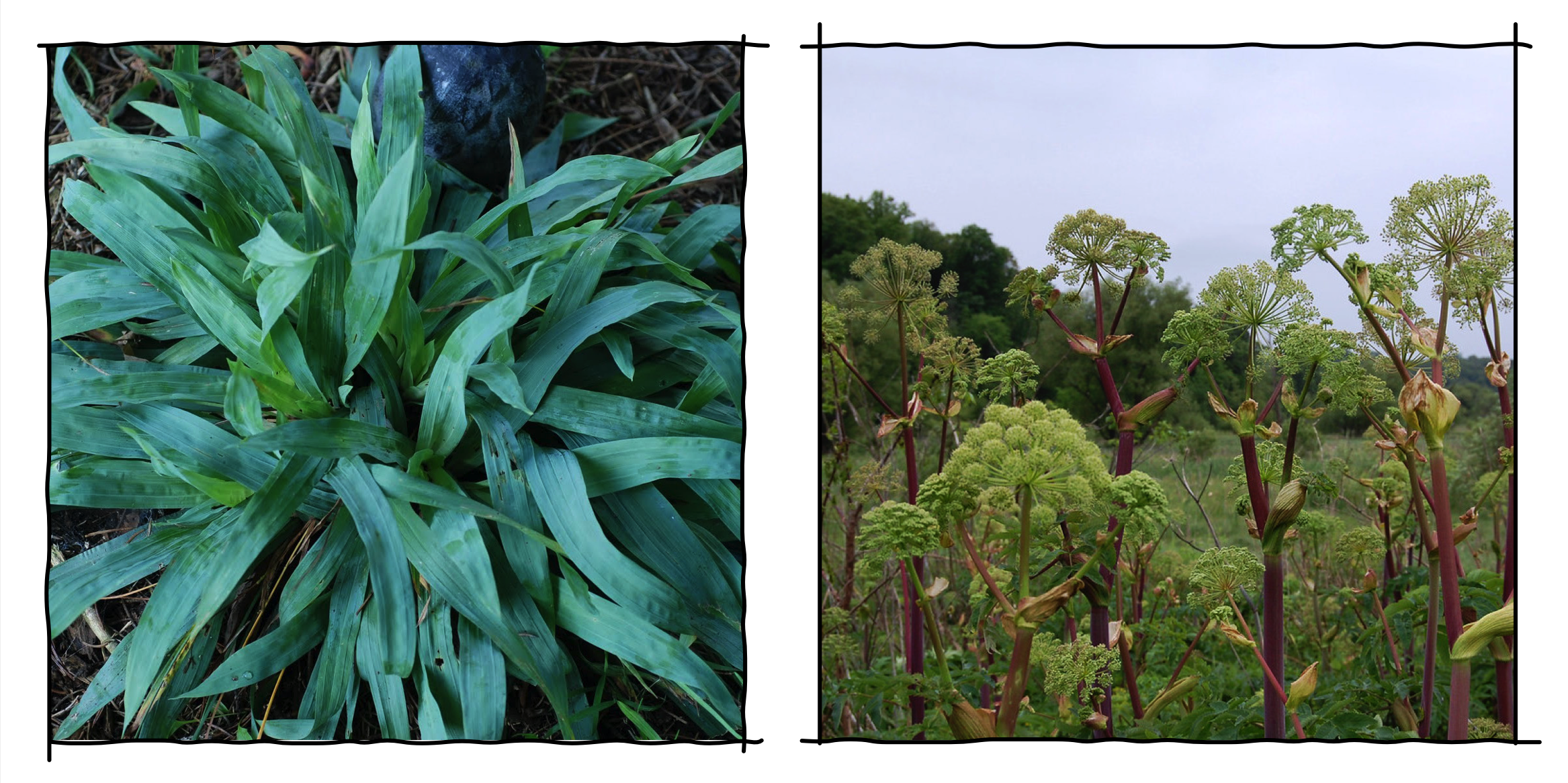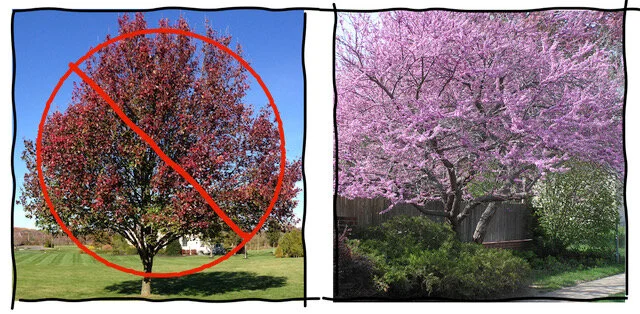We are all now no strangers to the fact that we should be using more native plants in our landscapes. I’ve said before that the goal is to have 80% of the biomass of your landscape plants be native, and as nurseries are carrying more and more of them it is easier to do now.
The easiest ones to find in local nurseries, the ones we all know and love, include Black-eyed Susan, Cardinal flowers, Butterfly weed, and Purple coneflower (actually not a NJ native), but there are many more cool native plants I’d like to introduce you to.
Some of the best perennials for supporting the eco-system are less familiar and may be a little harder to find, but worth seeking out; Baneberry, Jack-in-the-pulpit, Turtlehead, Wild Geranium, Beebalm, Beardtongue, Solomon’s-seal and Trillium. These workhorse perennials support insects, bees and birds, with berries, seeds, pollen and nectar.
Two of my favorite local growers are Toadshade Wildflower Farm and Wild Ridge Plants. One mail order, one pick up only. These are great resources and by buying from them you can support a NJ business and the ecosystem at the same time.
Toadshade Wildflower Farm is in Frenchtown, but is mail order only. Owner Dr. Randi Eckel is an entomologist so is in a unique position to offer insights on pollinators and the plants they prefer. She is growing over 500 species of native plants in her suburban back yard. As it is not zoned for commercial use she sells mail order.
You could also arrange pick up your plants at her local hardware store in Frenchtown, which is a good idea for a larger order as shipping can get expensive. I recently ordered a few hard to find plants for a total of 28.25 and the shipping was 27.97.
If you register for one of the many lectures Dr. Randi gives for the Native Plant Society of NJ, the Frelinghuysen Arboretum or a local garden club, she generally brings a good supply along to sell. If you are up to it, Toadshade also carries seeds for even more unique native perennials, and these are all locally sourced in New Jersey and nearby Pennsylvania.
Randi says asking about her favorite underused native plant, is ‘a bit like asking a parent to name their favorite child’. But she did give me a few ideas.
Strawberry Bush and Boneset
American Strawberry Bush, (Euonymous americanus), is the native version of the invasive Burning Bush (Euonymous alatus). This stunning 5’ tall plant sometimes called Bursting-Heart, is super showy in fall with scarlet fruit capsules opening to show orange seeds inside.
Late Flowering Boneset (Eupatorium serotinum) is a 5’ tall plant covered in small white flowers from September through November. Its long narrow leaves are a beautiful gray-green color. Its a great source of nectar late in the season for bees and butterflies. Salt and deer tolerant too.
Another great pollinator plant, Flat-Topped White Aster (Doellingeria umbellata) has big clusters of white flowers with chartreuse green centers in August and September. It is the host plant for several butterflies and moths including the rare Harris’ Checkerspot. It gets up to 4’ tall.
One of my favorites, Pasture Thistle (Cirsium discolor) is just what you think, one of the thistly purple plants seen growing along roads. This genus contains many pernicious weeds but this one is a good one. Find the right spot for this, and you’ll be rewarded because this tall purple fall bloomer is the host plant for Painted Lady butterflies, is a bird and bee magnet and the seed ‘fluff’ is used by goldfinches for nesting material. Grows just about any sunny spot, but its thorny so put in in the back of the border. The thorns keep the deer at bay.
The not so subtle giant Cup Plant (Silphium perfoliatum) gets to 7’. Perfoliatum means the leaves surround the stem, in this case forming ‘cups’ that catch water. You’ll find birds drinking from this after a rain. This hefty plant needs space, but in return will give you flowers all summer long. Attracts butterflies, skippers and bees and provides seeds for birds in fall.
When mine outgrew my small garden I dug it up, split it in two. Now one is thriving at mom’s house and on at a friends in Easton.
Wild Ridge Plants in Pohatcong Township, Warren County, is owned and operated by Rachel Mackow and Jared Rosenbaum at their farm. Rachel teaches foraging and has an herbal practice. Jared is a botanist and Certified Ecological Restoration Practitioner.
Their native plant nursery is on their farm, but please make an appointment. They are an all natural, chemical free business, and source all their seeds locally. They were certified ‘River Friendly’ by North Jersey RC&D in 2018. They recognize farms that protect our shared natural resources through responsible land management.
Asked about his favorite underused native Jared said ‘The more wildflower gardens I plant and the more wild areas I restore, the more I want to include native sedges in every planting palette. Sedges are grass-like plants with long leaf blades and a mounding or vase-like habit. Underground, they do remarkable work, weaving loose soil together with their fibrous roots. Sedges are the matrix into which I want to do my plantings, to build an undisturbed soil so the wildflowers feel at home, and reduce niches for weeds to recruit. Plus they have a beautiful architecture of their own’.
Broadleaf Sedge and Purplestem Angelica
I agree. Basically use sedges as ‘green mulch’, in-between all your other plants. There is a sedge for just about every habitat. Sunny wetlands to shaded woods. Jared favors Appalachian sedge (Carex appalachica) with fine leaves, and Rosy sedge (Carex rosea) for shaded woodlands and edges. Broadleaf sedge (Carex platphylla) and Spreading sedge (Carex laxiculmis) for their wide leaves.
A favorite of mine I spotted in the farms meadow is Purplestem Angelica (Angelica atropurpurea). A native cousin of Angelica gigas, an annual found in most nurseries. This girl gets 6’ tall and blooms in June with white balls that turn into super interesting seed heads. Great in a wet area or the back of a border with other giants like Joe Pye.
It’s hard to believe Turk’s Cap Lily (Lilium superb) is native, with its exotic looks and name. Orange flowers facing down, with their petals curled up like a…. turk’s cap, this beauty gets up to 6’ tall. Moist to wet soils, sun to shade.
This spring, plant more natives, interesting ones.









